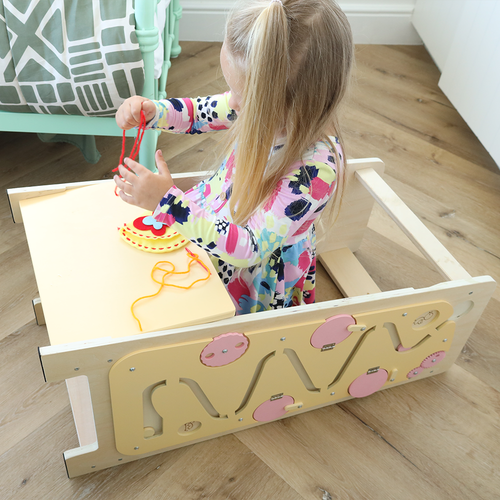
The Benefits of a Kitchen Helper Tower for Toddler
The Benefits of a Kitchen Helper Tower for Toddlers
Toddlers are naturally curious and eager to explore the world around them. As they develop new skills, they seek opportunities to participate in household tasks, especially in the kitchen, where vibrant colors, diverse textures, and enticing aromas capture their attention. A kitchen helper tower is an excellent tool for allowing young children to engage safely in kitchen activities. This blog post delves into the key benefits of using a kitchen helper tower for toddlers, highlighting how it fosters independence, supports developmental growth, and enhances family bonding.
What is a Kitchen Helper Tower?
A kitchen helper tower, often called a learning tower, is a child-safe platform designed to bring toddlers up to counter height. Unlike ordinary step stools, kitchen helper towers have safety rails or enclosed sides that prevent falls, making them a more secure choice for young children. Most models feature adjustable height platforms, ensuring the tower grows with the child.
Kitchen helper towers align with Montessori educational principles by encouraging hands-on learning and promoting independence. Their robust construction, non-toxic materials, and stability make them ideal for young children exploring kitchen activities.
Key Features of a Kitchen Helper Tower
- Safety Enclosures and Rails: Provide a secure environment.
- Adjustable Heights: Accommodate a growing child’s needs.
- Non-Slip Base and Sturdy Build: Prevent tipping and slipping.
- Compact or Foldable Options: Suitable for smaller kitchens.
Encouraging Independence and Confidence
One of the primary benefits of a kitchen helper tower is its ability to foster independence. Toddlers, inspired by their desire to mimic adults, can use the tower to access countertops and participate in kitchen tasks. Allowing children to contribute to simple household chores empowers them and nurtures a sense of capability and confidence.
Promoting Self-Reliance
When toddlers are given age-appropriate tasks, such as washing produce or mixing ingredients, they become active participants rather than passive onlookers. This engagement teaches them practical life skills and reinforces autonomy.
Building Confidence Through Achievement
Completing small tasks successfully builds a child’s confidence. Repeated exposure to real-world activities helps children develop a positive mindset toward learning and problem-solving. A study by Montessori educator Angeline Lillard (2017) emphasizes that children benefit from environments that encourage exploration and self-directed learning, both of which are facilitated by tools like the kitchen helper tower.
Enhancing Cognitive and Motor Skill Development
Participating in kitchen activities using a helper tower engages multiple areas of a toddler’s brain, supporting both cognitive and motor skill development. The act of climbing into and maneuvering within the tower improves gross motor coordination, while handling kitchen tools refines fine motor skills.
Gross Motor Skills
The physical effort required to climb in and out of the tower strengthens muscles and enhances balance. It also encourages spatial awareness as toddlers learn to navigate their movements.
Fine Motor Skills
Tasks like pouring, stirring, and peeling develop hand strength and dexterity. These activities also foster bilateral coordination—the ability to use both hands simultaneously—which is vital for later skills such as writing.
Cognitive Skills
Kitchen activities involve problem-solving, counting, measuring, and sequencing—all key cognitive processes. For example:
- Measuring flour or water introduces basic math concepts.
- Following instructions teaches sequencing and logical thinking.
According to research by Giedd (2004), experiential learning strengthens neural pathways, making tools like the kitchen helper tower powerful for brain development.
Strengthening Family Bonds and Creating Lasting Memories
Using a kitchen helper tower transforms routine cooking into quality family time. Toddlers love working alongside parents, and involving them in meal preparation strengthens emotional connections while teaching valuable lessons about nutrition and collaboration.
Quality Time Together
Preparing meals together allows families to communicate, share experiences, and create cherished memories. Activities like washing vegetables, kneading dough, or assembling simple dishes become bonding moments.
Teaching Teamwork and Patience
Collaborating in the kitchen teaches toddlers how to follow directions, wait their turn, and work as part of a team. These experiences instill patience and cooperative behavior, essential social skills for future interactions.
Practical Tips for Using a Kitchen Helper Tower Safely
- Always Supervise: Never leave your toddler unattended while using the tower.
- Start with Simple Tasks: Introduce easy activities like rinsing produce or spreading butter.
- Teach Safety Rules: Explain hot surfaces and sharp objects to build awareness.
- Incorporate the Tower Regularly: Make it part of daily routines to encourage consistent participation.
Conclusion
A kitchen helper tower is more than a simple piece of furniture—it is a gateway to independence, developmental growth, and family engagement. By allowing toddlers to explore and contribute to everyday kitchen tasks, parents foster skills that extend far beyond the kitchen. Investing in a quality helper tower provides lasting benefits, creating a foundation for lifelong learning and cherished family experiences.


